
Launch platform "Odyssey"
The fullest sense of presence, as in the case of the Vostochny cosmodrome , you will get by watching the 360 ° video.
The numbers are not always perceived by consciousness. The fact that the Sea Launch Commander is 221 meters in length does not mean anything. But the fact that it does not fit entirely into a telephoto lens from a distance of 300 meters, and you have to put a regular one, is already impressive. Our excursion started from the coast nearby, but, alas, because of the weather, the general appearance of the structures turned out to be "gray on gray" even with the intensification of colors during post-processing.
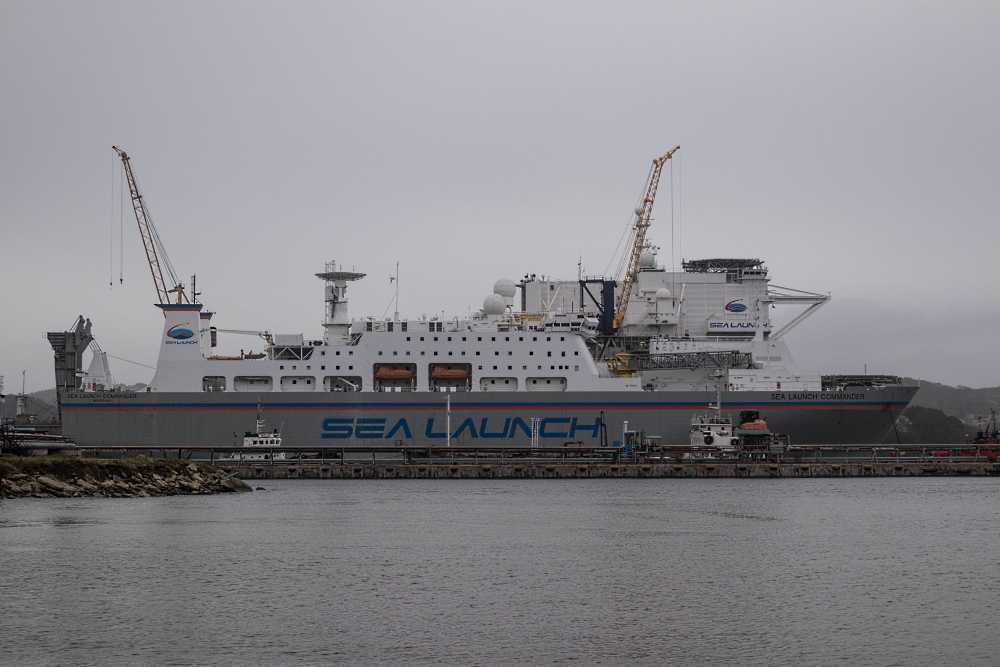
But close up, you already have to use the capabilities of the 360 ° camera, just so that the ships fit into the frame. The structure on the right at the stern is a ramp for reloading the rocket from the assembly-command vessel to the platform.

And between courts, even a 360 ° camera fails to cope, optical distortions destroy the majesty of the scene.
First of all, we rise to the assembly and command ship. Its design is based on Ro-Ro rokers (in English they are called RO-RO) - there is a large hangar along the entire hull, and living quarters and control rooms are located in the superstructure. Thus, the Sea Launch Commander is a relative of, for example, large ocean ferries. The assembly and command ship was built in Glasgow, refitted in Russia in 1997 and arrived at base in Long Beach, California the following year.
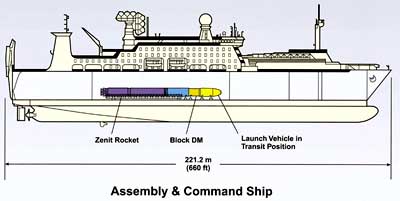
Illustration Sea Launch
For all the seriousness of the work being done, some of the design elements can hardly be called anything other than cute.

We rise to the fourth bridge deck. The name sounds unusual, but this is the official name, repeatedly applied to the walls. This is almost the very top of the ship. The antennas of the command-measuring complex are visible. They accompany the rocket and the upper stage even when the vessel is rolling. The Liberian flag waving nearby, a Sea Launch was registered there for a long time.

The deck offers excellent views of the launch platform.

For relocation to Russia, American and Ukrainian equipment was removed from Sea Launch in 2019. Therefore, we will see the bridge and launch equipment in excellent condition, but we will not see the disassembled control rooms from which the launch vehicle was prepared for launch. We pass to the bridge, it is made according to modern ship standards, and, for example, the bridgeicebreaker "Lenin" is made in a similar form factor and differs only in older equipment.
Left wing of the bridge, seating area and redundant control panel. Now it is not called "machine telegraph", but "remote automatic control" of engines.

A typical watch lasts four hours, so the bridge is equipped with facilities for drinking coffee.

View of the wheelhouse from the helmsman.
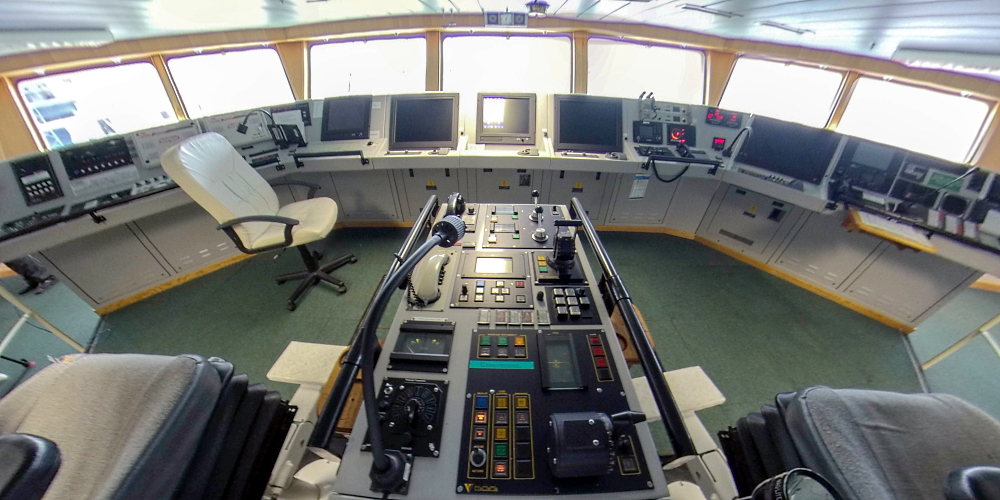
Close-up of the right side of the remote control. The red markings right in the center are wind data. Over the past 10 minutes, the wind has been blowing from the left shell with an average force of 8 knots. A very interesting instruction below - due to the fact that radio stations interfere with the reception of telemetry, they must be installed at a power no higher than one watt and used only when absolutely necessary.

Trackballs are practically extinct on home computers, but are common on ships, anti-aircraft missile systems and other mobile systems - they are fixed rigidly and will not fall off the table at the most inopportune moment.

Lighting control panels.

A very interesting huge table with a detailed diagram of the vessel and a set of templates for actions in emergency situations.

View from the center of the bridge forward. Directly in front of us is a helicopter hangar, to the right is a movable transition gallery, which was transferred to the launch platform. Pay attention to the emblems of the satellites that adorn the hangar. On the far right in the second row from the top in a mourning frame is NSS-8, the accident of which in 2007 became a turning point of the project - after it the flow of clients dried up.

Side view of the bridge, hangar and passageway for greater clarity.
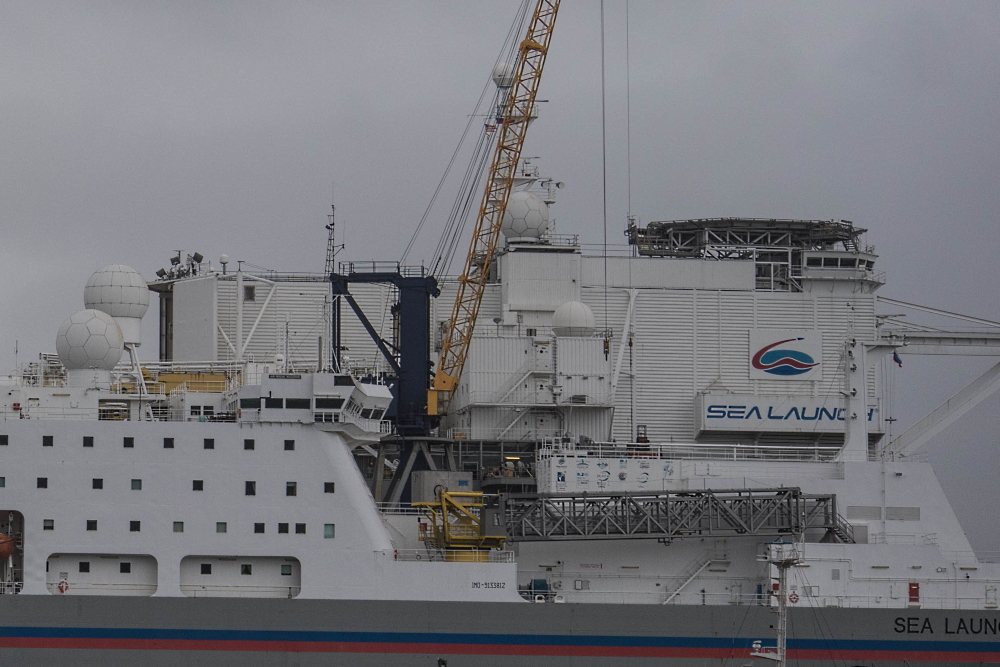
We go down one deck and find ourselves on, as expected, the third bridge deck. In the front there is something like a wardroom. The portholes look forward, and it turns out that on real ships you can find a complete analogue of Ten Forward (the bow compartment of the tenth deck) - the rest rooms and bar from Star Trek: The Next Generation. On the same deck there is a dining room, a gym and a cinema. The Sea Launch Commander has a crew of up to 240 people.

Our next stop is a hangar divided into several rooms for assembling the launch vehicle, preparing and refueling the upper stage. Curiously, our guide talked about how the warhead came as an assembly, with a bottom spacer, which was, in fact, overweight. Its sole purpose was to prevent access to the payload, and if Sea Launch returns to launches, then this spacer can and should be removed for its payloads. Now in the hangar, including the Russian equipment taken from the ground base in Long Beach is stored. In the photo we are looking at the stern of the ship (where the loading gate is). In theory, Sea Launch can leave the port with three missiles - one on the platform, two on the assembly and command ship, and shoot in a burst. But in reality, there was one launch for each exit to the sea. Considering the calculations,that to cover the costs it was necessary to make four launches a year, this especially did not affect anything. Moreover, on the one hand, going to the launch point from the port consumes the platform resource, but on the other hand, if you keep it at the launch point for a long time, then you need not only to overload the missiles at sea, but also to fill the platform with rocket fuel components, including evaporating liquid oxygen, and provide all the necessary people on it.and provide all the necessary people on it.and provide all the necessary people on it.

Sea Launch combines space and sea features in an interesting way. At the Vostochny cosmodrome, the rockets stand on wheeled structures for no reason - they will not roll by themselves. Here everything is fastened with ropes and chains to special holes in the deck so that it remains in place when rolling.

The assembled rocket leaves on a conveyor along the rails, but the kit also includes such a wheeled device. The blue container on the right was used to transport the DM-SL upper stage.

But this design is a slipway for working with the upper stage.

We pass to the launch platform. It was rebuilt from a North Sea drilling platform. The platform is shorter in length than the assembly and command vessel, “only” 137 meters. But on the other hand, its displacement in the semi-submerged position for launch is 50,600 tons. In the transit (raised) position, however, the platform loses to the "Commander" - 27,400 tons against 34,000. But the platform height at the helipad level is 71 meters. You can estimate the depth of the Odyssey's sinking by the large yellow markers on one of the columns. The widest line is the starting level.

We rise to the area of the reloading device. The platform columns stand on two floats, each as long as a modern nuclear submarine. They are related to the submarine by the presence of ballast tanks. By draining or filling them, the platform height is changed. The height of our site is around 50 meters.
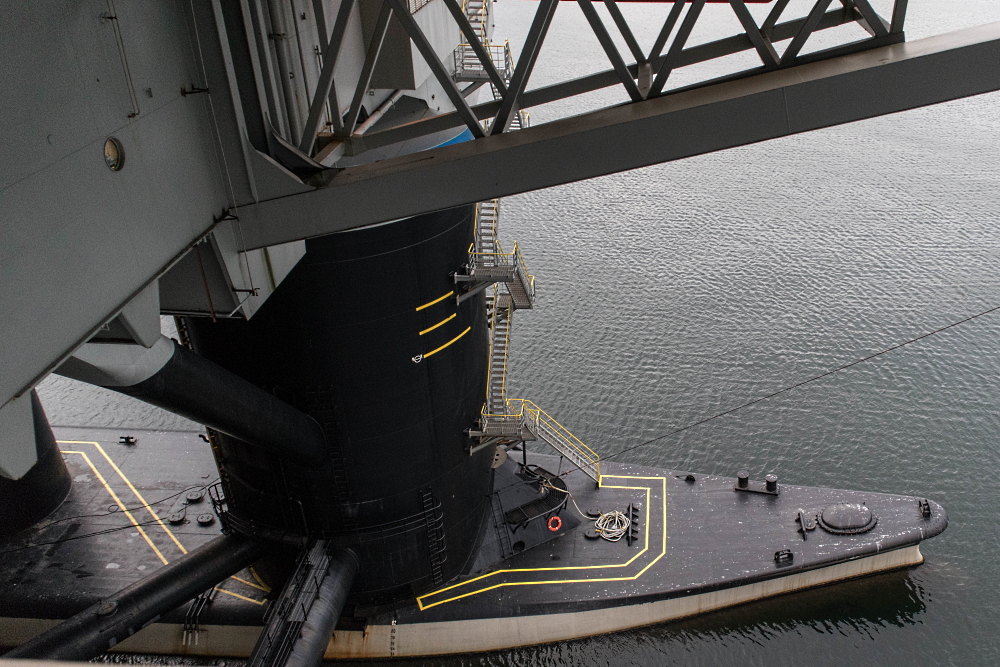
We pass to the hangar in which the assembled rocket was stored on the platform. The air conditioning system worked here and all the conditions were created for the rocket with the upper stage and payload to travel five thousand kilometers from Long Beach to Christmas Island in the Pacific Ocean. On the left is the loading gate, on the right is the start exit.

View towards the start. The weight of the installer is 140 tons, it was manufactured by Atommash in Volgodonsk.

Close-up of the installer's cart. A feature of the Zenit launch vehicle is a highly automated launch - all 68 people working on the platform leave it before launch - the main part through the rotating gallery, a small group, last of all, by helicopter. The launch takes place in automatic mode with remote control from the assembly and command vessel.

Outside view. The Zenit-3SL launch vehicle is long, almost 60 meters, and to install it in the launch facility it was necessary to remove part of the hangar roof, take a closer look, you can see the border between the fixed and removable roof. Pay attention to the gate - during the accident in 2007 , it was only slightly knocked off the guides by the blast.

We look into the gas duct. On the sides, you can see the covers that cover the rocket attachment points, refueling and other communications. The first stage of the Zenit launch vehicle is equipped with the most powerful liquid-propellant engine RD-171 with a thrust at sea level of 740 tons. Imagine how much power goes into this hole and is shared by the divider. If you watch the video of the launches , you can see that the entire launch deck is doused with outgoing gases.

The geometry will become clearer if we look at the same structure from below and from the side, from the pier. In general, the splitter is a common design at spaceports.

Against the background of the beautifully looking Sea Launch, the landscapes of the Slavyansk Shipyard look especially depressing. The bay was chosen because of the depth required for the floating spaceport, but it is not very suitable for basing - there is not enough power supply. Even if in Russia in November, as it recently appeared in the news, a consortium is created to revive the Sea Launch, two ships of the complex will have to be based somewhere for several years and undergo additional equipment for the Soyuz-5 rocket, which is close to "Zenith".
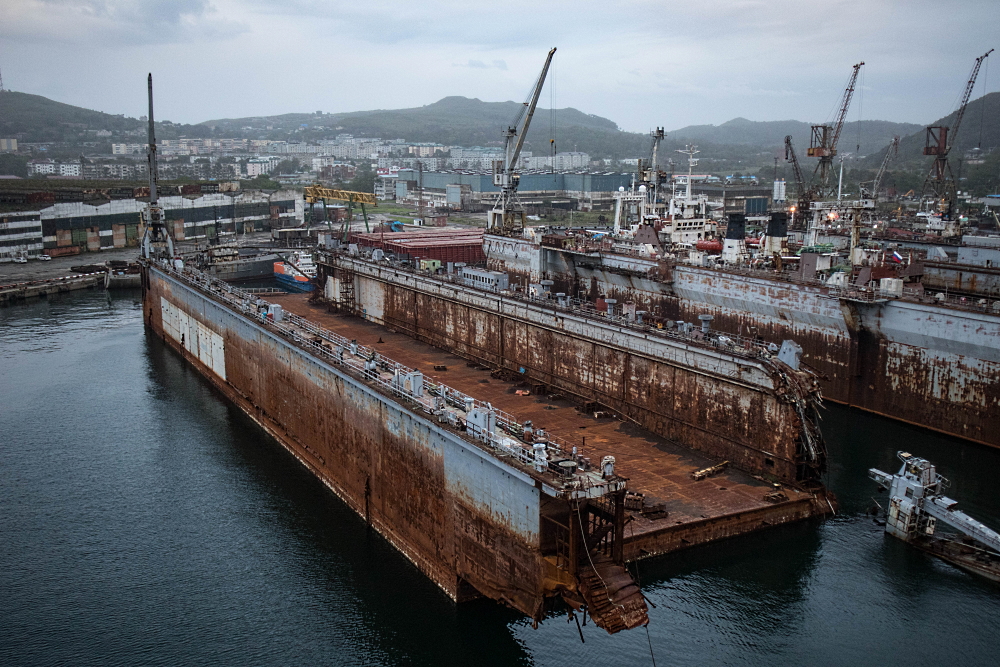
Who knows, maybe in a few years any of us will be able to fly to Vladivostok and photograph the platform leaving the launch site against the background of the Russian Bridge, and maybe even look at the launch - Sea Launch can be launched into polar orbits from anywhere, would be suitable drop areas. Income from tourism may well become a tangible addition to payments for launch services.
Additional materials: More detailed history of Sea Launch , history of Zenit launch vehicle .
I express my gratitude to Roscosmos for the invitation to the press tour.